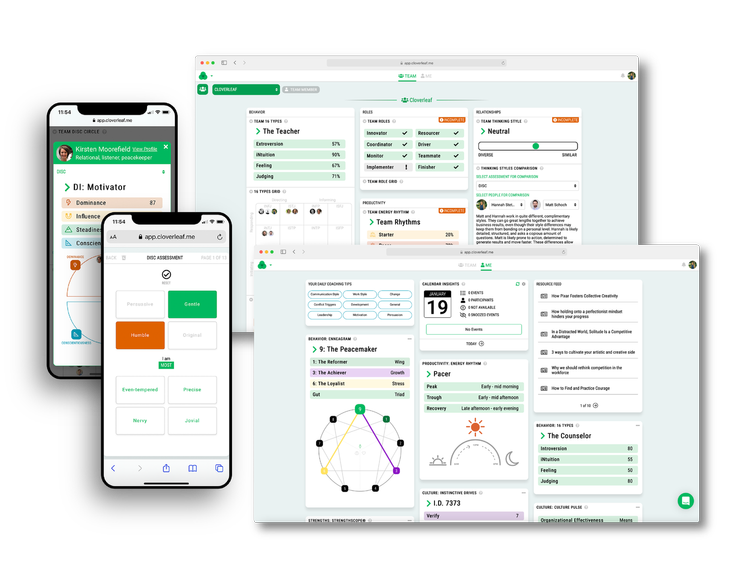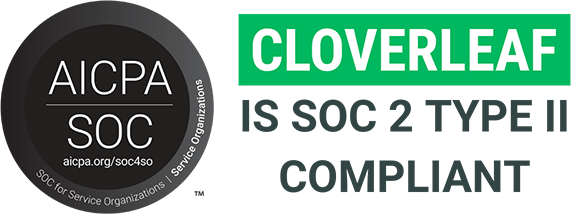In today’s rapidly evolving workplace, businesses constantly strive to improve employee performance and foster a motivating coaching culture. One emerging trend in achieving this goal is the use of Automated Coaching.
But why is Automated Coaching™ so valuable? As businesses aim to provide targeted and impactful coaching, they face challenges in developing effective training programs tailored to employees’ needs.
By leveraging data-driven insights and personalized coaching, organizations and teams can effectively identify skills gaps, develop tailored training programs, and drive learning and development initiatives aligning with organizational goals.
Let’s dive into what Automated Coaching™ is and discover why it’s quickly becoming an essential component of leadership development in the modern workplace.
Key Takeaways:
- Despite numerous L&D initiatives, employee behavior is only modestly impacted.
- Optimized learning occurs when the experience is customized, integrated into the workflow, and available on demand.
- Automated Coaching™ offers relevant, real-time prompts for improved emotional intelligence, communication, collaboration, and conflict resolution.
- Employees require smaller, well-timed insights that can be processed and applied daily for growth.
- Automated Coaching™ can scale to provide development opportunities for all employees.
The Problem with Traditional Learning and Development Initiatives
Leadership and development (L&D)—the process of helping employees increase performance and well-being in organizational settings—is a $366B industry. L&D is everywhere, with larger organizations having in-house L&D departments/positions, Universities offering L&D-specific degrees (e.g., master’s degrees, executive education), dozens of the world’s largest consulting firms specializing in L&D offerings, and hundreds of thousands of small businesses and solopreneurs engaging in L&D through individual and team-based coaching and consulting.
The problem, however, is that despite the sheer magnitude of L&D interest and initiatives, meta-analytic evidence suggests that its impact on employee behavior is relatively modest.
The source of the issue is that learning and development typically manifest as a one-time initiative where participants are inundated with recommendations. This approach is misaligned with the fact that human beings can only process and retain a limited amount of information in one setting. Further, L&D is typically delivered as a pre-packaged and static offering, which overlooks that individuals are different and that their priorities, careers, and lives are constantly in flux.
Research suggests that learning and behavior regulation are optimized when the experience is customized to users’ characteristics and needs, integrated within one’s workflow, and available on demand. Human beings can’t accommodate these features at scale, but technology certainly can. This is where Automated Coaching™ can make a substantial impact.
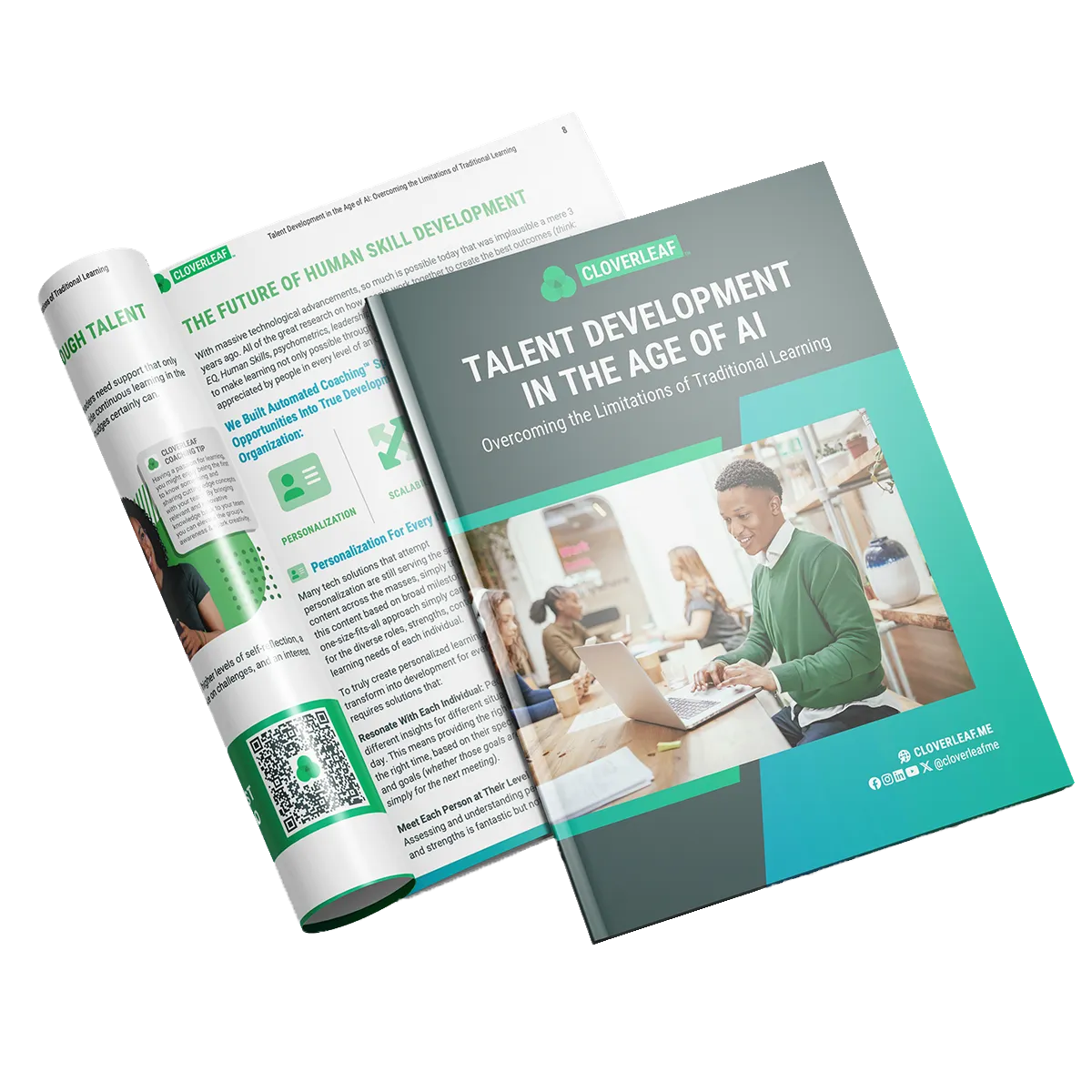
HUMAN SKILL PROGRAMS ARE HITTING LIMITATIONS...
5 THINGS THIS FREE RESOURCE WILL TEACH YOU
- Close the widening gap between learning and on-the-job application
- Overcome the tension of pausing productivity for development opportunities
- Integrate learning so it is actually in the flow of work
- The evolution of human skill development
- What Automated Coaching™ is and how it works.
Automated Coaching: The Evolution in Self-Directed Growth and Development
Traditional coaching entails the dyadic relationship between coach and coachees, which involves a process of collaborative goal-setting, constructing solutions, and fostering the coachee’s self-directed growth.
With Automated Coaching™, the goal is pre-defined (i.e., enhancing self-awareness and other-awareness), and the automated coaching system generates solutions that foster the coachee’s self-directed growth. In turn, Automated Coaching™ provides relevant, in-the-moment prompting and insight that individuals can directly apply to increase emotional intelligence, strengthen communication, identify opportunities for collaboration, and work through conflict successfully with teammates.
Cloverleaf uses assessment data to provide digital nudges to everyone within a team or organization to improve performance, increase managerial effectiveness, strengthen cross-functional collaboration, and inspire personal development.
A consolidated dashboard provides insights into employee strengths, weaknesses, and areas for improvement. From validated personality and strengths assessments to daily coaching, this approach can help organizations improve collaboration, strengthen performance, and better understand the needs of their teams.
How Automated Coaching™ is Revolutionizing Daily Growth and Development in the Workplace
One of the advantages of Automated Coaching™ is that it can be “pulled” at the coachees’ convenience and that it can be “pushed” every day, as many times as the system is programmed. Thus, unlike other L&D opportunities, Automated Coaching™ can facilitate coachee growth on a day-to-day basis. This approach aligns with several theories in organizational behavior.
First, according to social learning theory, human beings can only attend to, process, and retain a limited amount of information. Said differently, people can’t internalize information like super-computers. If organizations want their employees to grow, they must deliver smaller, digestible, well-timed insights that they can process and apply daily.
Second, research is being conducted in clinical psychology on using “micro-interventions”–small and short interventions void of human contact–that help patients with anything from anxiety to addiction.
These microlearning interventions align with what’s called metacognitive prompt theory, which suggests that you can nudge people to be more aware of their situation through purposeful reflection, which leads to more heightened self-regulation and behavior change.
Cloverleaf has researched this phenomenon, and the results are promising. The extent to which users engaged with the automated coaching program positively impacted several important outcomes, including an enhanced desire to learn more about themselves and their work, improved interactions with team members, and an overall better mood while at work.
Will Automated Coaching™ Replace Or Support Traditional Coaching Practices?

Automated Coaching™ will supplement, not replace, traditional coaching. Prior research illustrates that, when done well, coaching increases coachee performance and well-being.
Automated Coaching™ give coaches a more efficient method for staying connected with their coachees. It also gives them richer material to discuss with their coachees. In an ideal world, employees have access to both.
Unfortunately, many don’t experience the benefits of coaching, given the cost, lack of access, or time commitment. Technology can help close this gap by lowering costs and making coaching more scalable and widely available to diverse groups.
Is Automated Coaching™ The Same Thing As Artificial Intelligence?
Automated Coaching™ is broader than artificial intelligence (AI). However, where appropriate, AI can play a fundamental role in helping make Automated Coaching™ more adaptive and impactful.
We are far from “strong AI,” whereby machines are fully autonomous with general intelligence. Indeed, AI is making substantial process over the last decade, making it easier for organizations to incorporate into products like Automated Coaching™. However, applying “weak AI,” whereby specific algorithms are embedded to solve particular problems, is more representative of what coaching and Automated Coaching™ have the potential to incorporate in the short term.
How Can Leaders Rethink What's Possible With Coaching for Today's Workplace
Traditional coaching strategies have shortcomings that can be felt across an organization. However, scaling the development of team members is more tangible today.
As outlined here, there are four significant challenges to traditional coaching models that hinder their effectiveness in the workplace:
- It is often limited to the coachee’s perspective
- Providing a human coach is costly
- Relevance and timeliness are limited due to scheduling
- Proving impact that affects organizational results
As such, innovation is needed to address these challenges related to organizational training and development. Automated Coaching™ overcomes the challenges leaders are familiar with in delivering coaching to their employees.
Automated Coaching Is:
- Scalable
- Timely
- Measurable
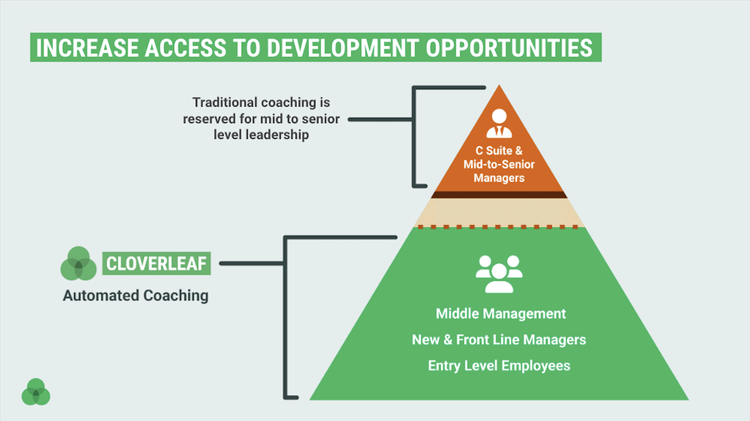
Unlike traditional coaching models, Automated Coaching™ can scale to increase access to development opportunities for everyone in an organization. This means that employee coaching is no longer limited to a select few but can widely extend throughout a company.
What’s more, Automated Coaching™ provides employees with a greater number of coaching moments than traditional practices. Instead of relying on monthly sessions where individuals hopefully gather a handful of understanding, Automated Coaching™ integrates into the user’s workday to offer in-the-moment, relevant insights and tips.
Additionally, Automated Coaching™ offers a unique advantage in the form of user feedback, allowing individuals to provide input on the coaching tips they receive. This immediate feedback response enables users to obtain better insights and more applicable coaching tailored to their specific growth. Therefore, Automated Coaching™ can adapt to the needs of each individual, making it a powerful tool for employee development and organizational performance.
Final Thoughts
As businesses seek new ways to streamline training and deliver impactful coaching, Automated Coaching™ provides a unique solution. With the ability to adapt to the specific needs of individuals, it is a powerful tool for employee development and organizational performance.
The future of leadership development lies in this customized, on-demand coaching that can enhance skills and increase performance, transforming the workplace for years to come.
Coaching in the workplace is a powerful tool that can help employees reach their full potential and maximize their performance. It provides employees with feedback, guidance, and support to help them reach their goals.
Coaching is one of several investments companies can make toward developing their people. This concept often falls under the broad umbrella of learning and development. This can include mentoring, training, and career planning.
What Is Coaching In The Workplace
Coaching in the workplace is a collaborative and empowering approach where the leader acts as a “thinking partner.” This strategy helps employees self-discover to reach their goals and objectives. Therefore, coaching differs from giving orders or dictating how the employee should work. This approach allows employees to take ownership of their development and feel more motivated and engaged.
Key Takeaways:
- Leaders who coach are thinking partners to collaborate rather than dictate.
- A coaching approach can help employees take ownership of their development and feel more motivated and engaged in their work.
- Asking questions can help leaders coach teammates more effectively.
- A coaching culture can support a positive environment and foster growth
- Each situation and employee is unique.
How Is Coaching Employees Different From Traditional Management
3 Ways Coaching Is Different From Other Management Strategies:
- Coaching focuses on discovering rather than controlling
- Leaders who coach are thinking partners to collaborate rather than dictate
- A coach is goal-oriented rather than process oriented
One big difference is that coaching focuses on helping employees develop their conclusions to reach their goals, rather than simply managing their tasks and work output.
This means that a coach will work with an employee to identify areas for improvement, set goals, and create a plan to achieve those goals by serving as a thinking partner rather than commanding and controlling every step.
Coaching is a more collaborative and empowering approach. Therefore, leaders who act as coaches work with employees as partners rather than giving them orders or dictating how they should work. This approach helps employees to take ownership of their development and feel more motivated and engaged in their work.
Coaching leads to success because it facilitates psychological capital, a positive psychological resource that coachees can apply to their day-to-day work experiences. – psychologytoday.com
Traditional management often solely focuses on improving the team or organization’s performance. Coaching focuses on helping individual employees self-discover and reach their potential.
A coach will help employees to set and achieve goals, whereas a manager will focus on maintaining processes and procedures.
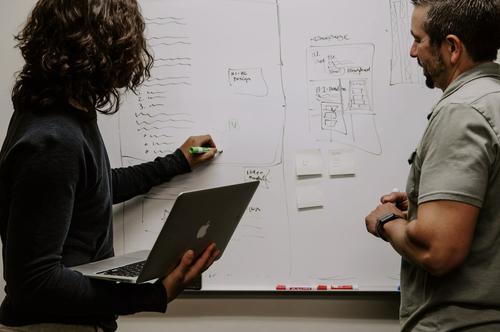
How To Implement Coaching In The Workplace
Companies continue to increase their investment in coaching as a leading form of developing their talent. Recent studies indicate that 9 out of 10 companies plan to increase their investment in coaching over the next 12 months.
Coaching can happen with trained professionals contracted from outside your organization, or they could be dedicated professionals that work inside the organization (often in HR or Talent Management groups), or it can be managers acting as coaches by using a coaching approach.
A recent Harvard Business Review Article advocates that successful leaders are great coaches by discussing this concept and urging for leaders to act as coaches.
You can introduce Automated Coaching™ to your team by incorporating the Cloverleaf Team Dashboard into your daily workflow. This will help you and your team gain helpful insight about one another and coaching tips to increase understanding, collaboration, and performance.

HUMAN SKILL PROGRAMS ARE HITTING LIMITATIONS...
5 THINGS THIS FREE RESOURCE WILL TEACH YOU
- Close the widening gap between learning and on-the-job application
- Overcome the tension of pausing productivity for development opportunities
- Integrate learning so it is actually in the flow of work
- The evolution of human skill development
- What Automated Coaching™ is and how it works.
How To Develop Skills To Be A Better Coach As A Leader
While coaching may come more naturally to some leaders than others, there are effective ways that everyone can try to hone their coaching skills to be a more collaborative teammate.
Below are some of the best questions and prompts for leaders to ask when they are seeking to help coach a team member.
- Tell me about your goals and objectives.
- What are your strengths and weaknesses?
- Describe the challenges are you currently facing.
- What resources or support do you need to achieve your goals?
- How can I best support you?
- What do you think should be our next steps?
- What are your thoughts about how I help you to improve?
- How do you feel about your current progress?
- How do you think this situation could have been handled differently?
- What are your thoughts on your role in the team?
It’s essential to be flexible, adaptable, supportive and encouraging in your coaching approach.
When coaching team members, leaders should ask questions that focus on the following:
- Identifying goals and objectives
- Strengths and weaknesses
- Challenges
- Resources or support needed to achieve goals.
Asking questions that empower employees to take ownership of their development, reflect on past experiences, and learn from them and their role in the team can also be insightful.
Examples Of Successful Coaching Moments At Work
Unfortunately, it isn’t enough to believe coaching is valuable. Managers and leaders need not only to know how to coach but also to match the coaching technique and approach with the needs of their people. And people are complicated with needs that are unique and varying.
Below are several examples of coaching scenarios to help you better understand how each situation is unique and why the needs of each team member are different.
1. A SALES MANAGER STRUGGLING TO CLOSE DEALS
An experienced sales manager has been struggling with closing high-value deals. The manager’s leader works with them by asking questions to help identify their specific challenges, such as a lack of confidence in their pitch or difficulty building trust with potential clients.
Together, they set goals to improve the sales manager’s communication skills and create a plan to practice and build their confidence. Through regular one-on-one sessions, the leader seeks to help the manager discover practical ways to close more deals and exceed their sales targets.
2. A NEW EMPLOYEE IS STRUGGLING TO ADJUST TO THE COMPANY CULTURE
A new employee is having difficulty adjusting to the company’s culture and workflow. Their leader identifies a project they can work together on to help better understand their strengths and weaknesses.
The leader helps the new employee to create specific goals by asking them what actions they believe are most important to help support the team’s overall objective. The leader also provides consistent input on the employee’s progress by focusing on the goal rather than the process of completing it.
3. A Team Leader Faces Communication Challenges During Remote Work
A team leader is responsible for managing a remote team. The team leader’s boss asks questions to help clarify what is currently working and where there are challenges. Identifying these pain points has helped the team leader discover which areas to address first.
There are tremendous impacts of incorporating coaching in the workplace. Still, organizations often only roll out models or methodologies for coaching. They may even provide some basic training on effective coaching. However, this often stops short of providing valuable tools that help managers and leaders coach the individual needs of their employees.
Why Is Coaching So Important In The Workplace
Coaching in the workplace can significantly impact employee performance and development because it empowers them to self-direct and discover ways of working that lean into their strengths.
Leaders can help team members better understand their strengths and weaknesses and prioritize personal development in the workplace, leading to greater job satisfaction and employee retention.
Additionally, coaching can support a positive work culture and foster a sense of growth and development among the employees, which can significantly benefit the organization.
5 Benefits Of Utilizing Coaching In The Workplace
1. Improved Performance
Coaching can help employees identify areas of improvement and set goals for themselves, which leads to improved performance. Coaching also helps employees stay focused and motivated to reach their goals, providing the necessary support and feedback to help them get there.
2. Increased Morale
Coaching in the workplace can help create a positive working environment and increase morale. Employees who receive feedback and support from their leader are more likely to feel motivated and engaged.
3. Improved Communication
Coaching helps teammates develop communication skills and express their ideas and thoughts effectively. Strengthening this skill can help build strong relationships between team members, even in remote collaboration environments.
Coaching can help employees learn how to manage and resolve conflicts at work effectively. Reducing stress and creating a more productive work environment make for a happier workplace.
5. Increased Retention
Coaching can help employees feel valued and appreciated. This can help improve employee retention rates and create a happier and more productive workplace.

Coaching in the workplace is an invaluable tool that can help employees reach their full potential and maximize their performance. It provides employees with the necessary guidance, feedback, and support to help them reach their goals and succeed.
Next Steps To Provide More Coaching At Your Place Of Work
As an enterprise leader, just believing or saying that coaching is an integral part of your learning and development investment is like asking your managers to be a carpenter but not giving them a hammer and nails.
Cloverleaf can be the tool that is an essential part of any manager’s toolkit. A perfect example of this is recognition. Some team members may need public recognition- this could happen by giving a shout-out at an all-team meeting, a mention on the company website, or a shared channel in Slack.
Other team members may want a more private, personal recognition. This could include a simple email, handwritten note, or MS Teams message that indicates you saw their contribution in the meeting and appreciated it.
Knowing these differences and how to use them for the right person in the right situation is the key to effective coaching, and Cloverleaf can provide you that insight daily within the tools you use every day.
Start a free trial today to learn more, discover its features, and experience the power of coaching at your workplace.
The coaching industry is a dynamic and colorful industry. It has given us the likes of Tony Robbins, Marshall Goldsmith, and Sheila Goldgrab and helped millions of people discover who they are and how to succeed in whatever chapter of life they are in.
Though coaching has made its way into the mainstream and adopted new and innovative approaches to engaging with coachees, the model most coaches use to facilitate coaching moments hasn’t changed much in the past generation.
Most training and development resources still rely on information consumption models that are still susceptible to the forgetting curve hypothesis, which indicates that people’s memory, even of valuable information, will atrophy over time (and often very short periods of time) without good practices to retain it.
Plus, many assessment tools still use underlying research and analysis from Carl Jung and haven’t evolved much other than newer and fresher coats of paint (think colors instead of numbers, birds or animals instead of letters).
Even the coaching industry’s approach hasn’t changed much over the decades. Hourly sessions, at regular intervals, followed by the occasional check-in for accountability.
Valuable coaching conversations can lose momentum because they are confined to limitations familiar to common coaching approaches. However, in the moment coaching, especially within the workplace, is in greater demand and more relevant than ever.
Why Are Coaching Moments At Work So Valuable?
A coaching culture creates opportunities for managers and peers to help develop one another’s skills and performance.
Coaching is invaluable if an organization is to achieve its goals. It should be part of the continuous employee performance management by managers to maximize the potential of the employees. – quantic.edu
The benefits of a coach helping a team or individuals work through challenges can impact results that extend throughout the entire organization.
People are complex, and the best coaches consider context, realizing that every situation is different and requires nuance.
At Cloverleaf, we love coaches and believe strongly in the value they can provide to a team. But also believe it worth acknowledging that there are shortcomings to traditional coaching models that coaches and leaders need to consider.


HUMAN SKILL PROGRAMS ARE HITTING LIMITATIONS...
5 THINGS THIS FREE RESOURCE WILL TEACH YOU
- Close the widening gap between learning and on-the-job application
- Overcome the tension of pausing productivity for development opportunities
- Integrate learning so it is actually in the flow of work
- The evolution of human skill development
- What Automated Coaching™ is and how it works.
3 Challenges To Traditional Coaching Models:
Scalability
- Providing a human coach for everyone in the organization is cost prohibitive, and finding or training enough available coaches is difficult. Not to mention that there are diminishing marginal returns if everyone had a coach.
Timeliness
- A once-a-month connection between an individual and their coach can restrict relevant, timely coaching specific to the immediate problems that managers, leaders, or individuals face throughout their days/months.
Measurable Impact
- Proving and improving impact has been a challenge for the industry.

Often, even the best coaching relationships may only make the coachee feel better that they are doing something to improve themselves. But what about the ability to verify clear, measurable outcomes that indicate organizational results?
Measurement is another critical area where there hasn’t been much innovation in coaching solutions. Solving these three significant problems requires defining the long-term goal of coaching in the workplace.
What Is The Goal Of A Coaching Moment?
When I ask people in our network about their experience with a coach, they will often recall the last coaching session and point to some insight or discovery gained during that session.
Next, I follow up with a question about frequency – specifically, how many of these insights they typically encounter during an average 1-hour session. They may pull out a notebook and reference 3-5 bullet points of takeaways.
Typically, to measure the impact of those 3-5 insights, one could consider several points of impact:
- Leadership effectiveness
- Performance reviews
- 360 scores
While these are important indicators, the measurable impact of the coaching is limited because they only reflect a point in time concerning the individual (often without ongoing measurement or prone to inconsistent measurement over time.)
Plus, there are several additional factors (pay, relationships, proximity to the work, etc.) that can skew the results.
There is room for improvement. At Cloverleaf, we have a North Star that guides our measurement of successful employee coaching to ensure it is precise and worthwhile. It also influences all the product features and market decisions we make.
We call this North Star – ‘Successful Coaching Moments.’
The goal of every coaching moment in the workplace should be to improve emotional intelligence, collaboration, and organizational impact.
To determine our proximity to reaching this North Star, we measure the following elements (like any good North Star metric):
Reach or breadth of people (known internally as coached users)
- This element reflects how many team members or employees within an organization are impacted by Cloverleaf’s Automated Coaching™.
Depth or levels of impact (known internally as successful coaching per day)
- Unlike most coaching practices that depend on the 3-5 insights gathered within a 1 hour per month session – Cloverleaf’s typical user experiences, on average, nine successful coaching moments per day.
Frequency (known internally as days coached per month)
- Cloverleaf can help you reach clients and teams daily. Rather than waiting weeks until the next coaching session, coaches can foster consistent development to keep their clients on track.
Measuring the reach, depth, and frequency of the coaching at work teams’ experience provides context that can ensure ongoing coaching in the workplace is happening and that users are less susceptible to pitfalls like the forgetting curve or slow progress.
At this point, the big question you may ask yourself is, ‘how do we know if in the moment coaching tips are successful?’
After all, that is the key to overcoming the current shortcomings of standard approaches to coaching and capturing true impact. Further still, how can we ensure that results are accurate and not impacted by several other factors? How do we PROVE that Automated Coaching™ is successful?
How To Know If Coaching Moments Are Successful Within Your Team
The best way to determine if coaching is successfully impacting your team is by using data that can indicate an increase in emotional intelligence, improvement in collaboration, and organizational performance.
Additionally, gaining a pulse on team culture and how applicable the coaching is can help leaders accurately assess the value of in the moment coaching.
With Cloverleaf, coachees can rate every piece of coaching content. With each coaching tip, we ask simple questions like, was this coaching helpful? This immediate feedback is a starting point for users to provide even more context concerning the effectiveness and relevance of the coaching they receive.

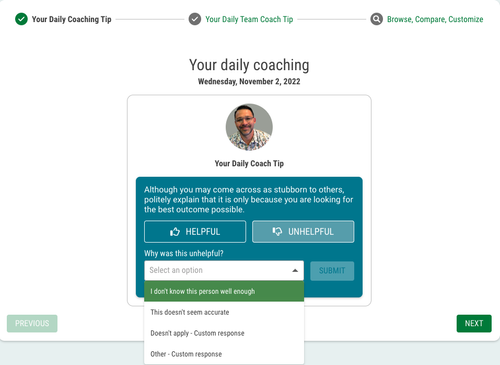
Next, team members can respond to additional contextual questions concerning why that coaching was helpful or unhelpful.
All of these data points are significant because they offer insight that correlates with the team and organizational sentiment, relevance to their role, and the ROI of Automated Coaching™.
The Big Question
The most important question is, how do we know that Automated Coaching™ improves emotional intelligence, team effectiveness, or belonging?
Cloverleaf’s Chief Research Officer, Scott Dust, runs regressions against the data to isolate the impact of Cloverleaf on outcomes, and here are some of the results.
Our monster pilot data essentially says that as the number of coaching moments increases, so does the increase in (a) team effectiveness, (b) feeling recognized by team members, and (c) feeling as if one’s strengths are valued by others.
These are great results, and we plan to further extend this analysis. We believe that Cloverleaf (an Automated Coaching™ solution) when used in conjunction with a human coach, can take employee and organizational development to even greater heights.
Cloverleaf is helping People Strategy Leaders change how they develop their leaders. Scaling coaching opportunities for leaders and managers is possible with access to popular validated assessments, personalized dashboards, and in-the-moment coaching tips.


